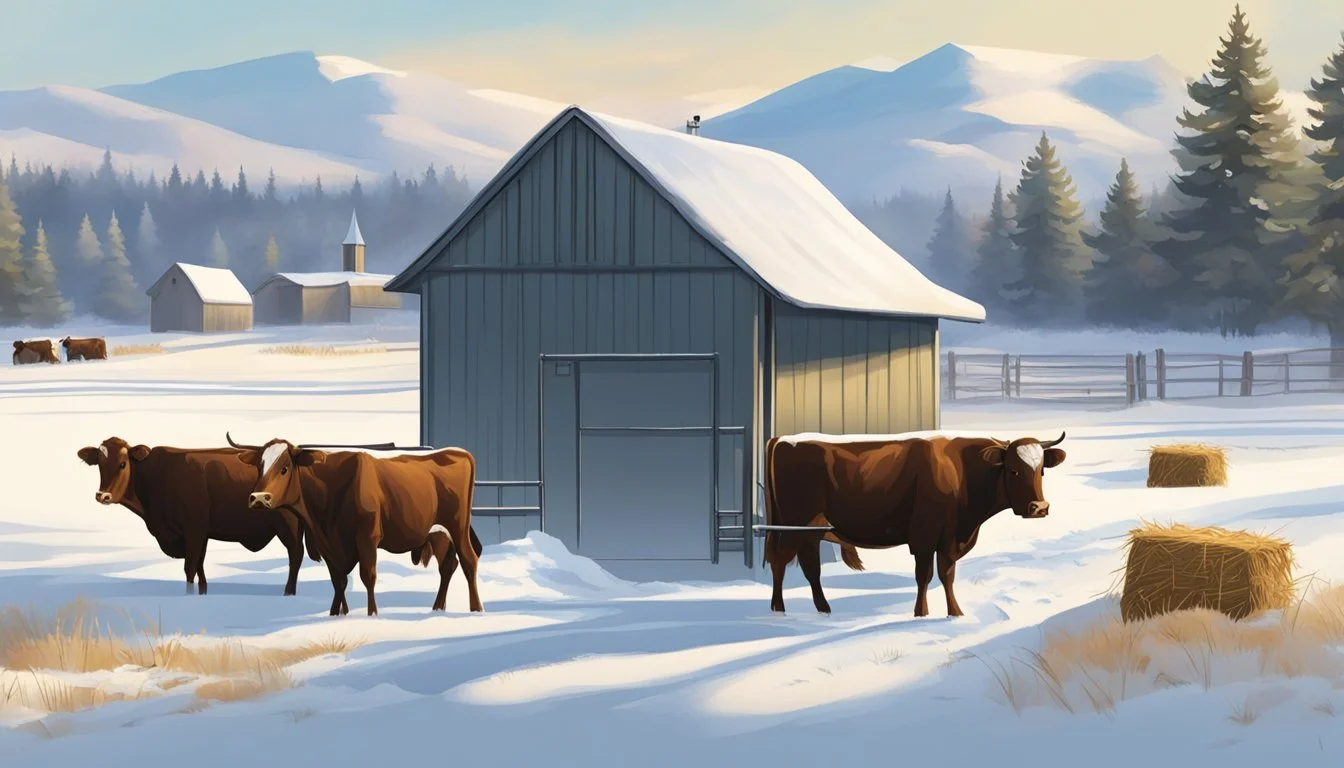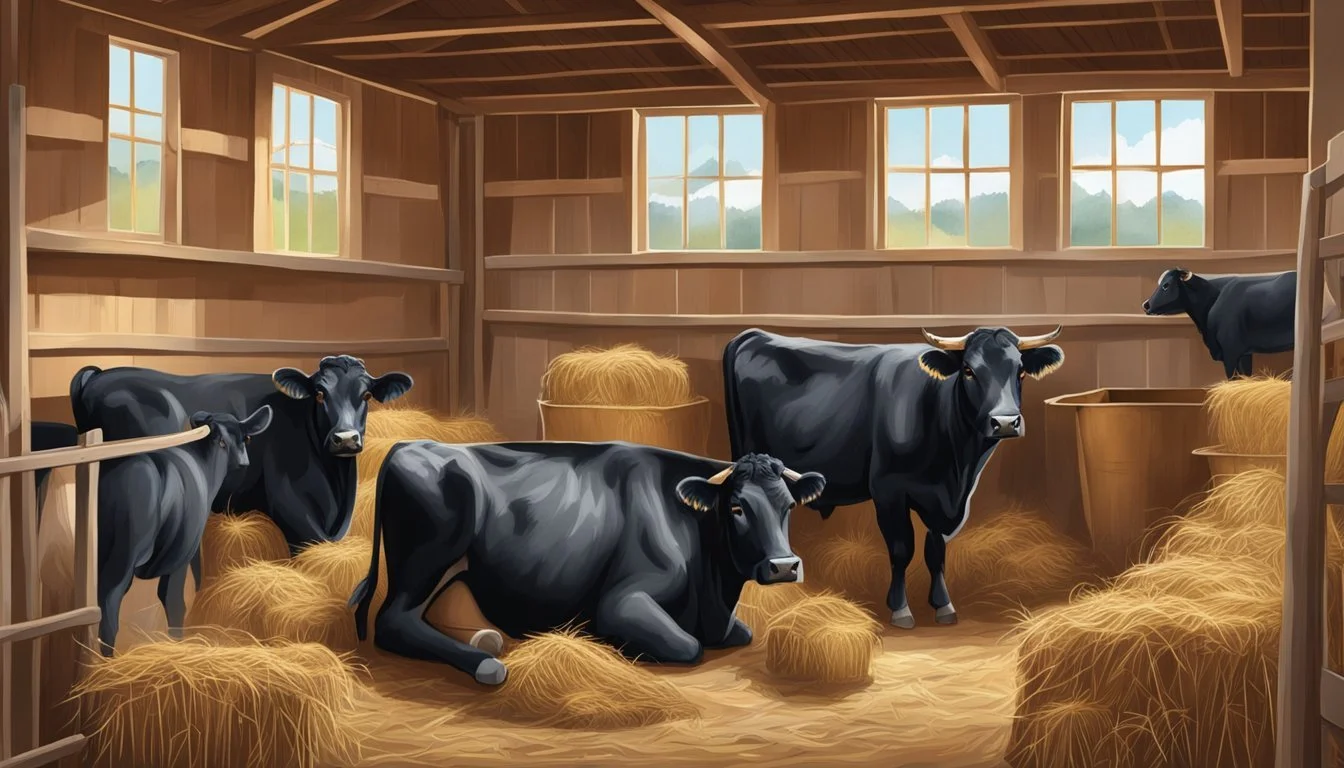Winter Care for Dexter Cattle
Essential Tips for a Healthy Mini Herd
Dexter cattle, an Irish breed notable for their smaller stature, are celebrated for their hardiness and adaptability, making them an excellent option for homesteads and small-scale farms. Originating from the rugged landscapes of Ireland, these cattle are renowned for their ability to thrive in various climates. Their compact size not only endears them to those with limited acreage but also enhances their manageability, an attribute particularly appreciated during the winter months when animal welfare is paramount.
Winter care for Dexter cattle is crucial for maintaining their health and comfort during colder temperatures. Providing an environment that shelters them from harsh weather, along with appropriate feed to sustain their energy needs, ensures they remain in good condition throughout the season. Their hardy nature, combined with proper management practices, allows Dexter cattle to continue thriving despite the challenges winter presents. The natural resilience of Dexter cattle, coupled with thoughtful husbandry, can result in a herd that is both productive and resilient in the face of winter's demands.
Understanding Dexter Cattle
Dexter cattle originate from Ireland and have distinctive characteristics that have made them a popular choice among small-scale farmers and homesteaders. Recognizable by their smaller stature, Dexters are a dual-purpose breed, meaning they are raised for both meat and milk production. Typically, the breed comes in three colors: black, dun, and red.
Physical Traits:
Size: Small, compact body with broad shoulders and well-rounded hindquarters.
Height: Comes in short or long-legged varieties.
Appearance: May have horns or be naturally polled (hornless) due to selective breeding.
Uses:
Beef: Dexters are efficient converters of feed into meat, with a higher percentage of usable meat yield compared to many other breeds.
Milk: The milk produced by Dexter cows is rich in nutrients and high in butterfat content, which is favorable for cheese-making.
Benefits of Raising Dexters:
Hardy and adaptable to various climates.
Capable of thriving on pasture-based diets with or without grain supplementation.
Known for their easy handling and docile temperament, making them suitable for first-time livestock owners.
Dexter cattle, categorized as a small-size livestock breed, provide a sustainable option for those aiming to cultivate beef and milk while managing smaller land areas. They are a versatile and practical choice for achieving self-sufficiency in food production.
Nutritional Requirements in Winter
Dexter cattle's nutritional needs during winter are critical for maintaining health and withstanding the cold. Proper nutrition ensures they have enough energy for thermoregulation and supports overall well-being.
Importance of Hay and Forage
In the winter months, Dexter cattle rely heavily on hay and forage as natural pasture resources dwindle. These should be high in nutrients and fiber to promote a healthy digestive system. It's important that the hay is not only plentiful but also of good quality, with an optimal balance of protein and energy levels to meet the cattle's increased caloric demands.
Forage Types: Legumes and mixed grass hays.
Quality Indicators: Green color, fresh smell, free of mold/dust.
Grain and Supplemental Feed
Grain and supplemental feeds can be provided to ensure cattle receive adequate fat and energy. These supplements are beneficial when forage quality is poor or when extra energy is needed during extremely cold periods.
Supplement Types: Corn, barley, oats (among others).
Protein Supplements: Soybean meal, linseed meal.
Nutrient-rich minerals and vitamins should be part of the diet.
Ensuring Adequate Water Intake
Hydration remains crucial in winter; cattle need consistent access to a water source. Tank heaters or insulated water troughs are often necessary to prevent freezing. Water intake aids digestion and is vital for overall health, yet is often overlooked during the colder months.
Water Requirements: 5 to 15 gallons per day, depending on size and diet.
Monitoring: Check water sources daily for accessibility and cleanliness.
Body Condition Scoring for Health Management
Body condition scoring (BCS) is a practical method to manage cattle health. Scoring should be done early, with a target BCS of 5 or 6 for optimal winter durability. Adjust feed intake to improve or maintain the desired score throughout the season.
Scoring Frequency: Regular intervals, before winter and during the season.
Adjustments: Increase feed or adjust diet based on BCS results.
Shelter and Environment Adaptations
In cold climates, ensuring the well-being of Dexter cattle involves creating a suitable sheltered environment and adapting pasture spaces to provide comfort and protection against winter elements.
Designing Windbreaks and Shelter
Wind protection is crucial for Dexter cattle during winter. Windbreaks can significantly reduce wind speed and provide an area of relatively calm air on the leeward side. These structures come in various forms, such as built shelters or natural barriers like dense shrubbery or tree lines. The size and design of windbreaks should correlate with the herd size to ensure ample space. For maximum effectiveness, shelters should be oriented perpendicular to prevailing winds and sufficiently sized to shelter the entire herd without overcrowding.
Bedding for Warmth and Comfort
Bedding plays a vital role in insulation and moisture absorption, keeping the cattle dry and warm. Materials like straw are often used for bedding due to their excellent insulative properties. It's essential to provide a deep, dry bedding layer and to refresh it regularly to maintain its insulative quality and to prevent the development of bacteria and parasites. For Dexter cattle, a smaller-sized breed, the amount of bedding should be scaled appropriately to ensure they are not overwhelmed by the bedding depth and can comfortably stand and rest.
Adjusting Pasture Space and Availability
During winter, available pasture space might decrease due to snow coverage and the cattle's decreased mobility in harsh weather conditions. Ensure that Dexter cattle have enough space to move without stressing for resources. Smaller pastures with easy access to windbreaks and shelters can benefit the herd by reducing exposure to cold and facilitating ease of access to food and water. Moreover, rotating pasture use can help prevent soil erosion and maintain the quality of grazing space throughout the winter.
Health and Welfare During Cold Months
Dexter cattle, known for their hardiness, still require meticulous care in the winter months to prevent stress, manage diseases, and ensure the well-being of the herd, especially during calving and for young calves.
Managing Stress and Cold Stress
In winter temperatures, Dexter cattle experience increased energy demands; providing sufficient nutrition is essential to maintain body heat and overall health. Shelter, serving as a barrier from wind and extreme cold, together with deep, dry bedding, helps mitigate cold stress. It's important to monitor the cattle closely for signs of discomfort or hypothermia, as prolonged exposure to cold can severely affect long-term herd health.
Parasite and Disease Control
With a focus on health management, winter is the opportune time for controlling parasites like lice, as well as for updating necessary vaccinations. A comprehensive deworming program, tailored for winter conditions, alongside consistent monitoring for external parasites, contributes to the overall health and comfort of the herd. Regular health checks and a vaccination schedule should not be overlooked, despite the cold.
Special Care for Calving and Young Calves
Newborn calves are particularly susceptible to winter stressors including frostbite and illnesses. It's imperative that calving areas are well-protected and that calves receive adequate colostrum to build up their immune system. Prompt identification and management of hypothermia in newborns are critical for survival. Dexter cows should also be in optimal body condition to support the increased energy requirements during lactation and to ensure the warmth and vitality of the calves.
Special Considerations
In managing a herd of Dexter cattle during winter, specific strategies ensure their well-being and productivity. They must have access to unfrozen water, receive energy-rich feed, and have their breed-specific needs met to maintain optimal meat and milk production.
Managing Water Sources in Freezing Conditions
It is crucial to keep water sources for Dexter cattle accessible and ice-free. Insulated or heated water systems, such as a heated trough or a water hydrant with a heat tape, should be employed. Regularly checking and breaking ice on ponds or streams is also important to ensure a consistent water supply.
Feeding Strategies for Energy and Heat Production
Dexter cattle require a diet that supports both digestion and energy levels, helping them to produce body heat. Adequate hay, which ferments in the rumen generating heat, and an increase in caloric intake through grain supplementation are key. The feed should be rich in fiber and provided in a way that minimizes waste, such as using a hay feeder with a roof or cover.
Optimizing Meat and Dairy Productivity
To maintain meat production with a rich flavor and tenderness, as well as a consistent milk production of rich milk with excellent flavor, the nutritional needs specific to Dexter cattle must be met. This dual-purpose breed benefits from a balanced diet tailored to cold weather, possibly including beet pulp or other energy-dense supplements to support their smaller stature and robust productivity.
Breed-Specific Traits and Uses
Dexter cattle have unique qualities as a dual-purpose breed, effective as both dairy and beef producers. They are known for their hardiness, making them well-suited for various climates. In the winter, their adaptability allows them to thrive when special considerations, such as providing shelter from harsh conditions, are taken. Furthermore, as oxen, they can serve as draft animals, requiring good nutrition and care to continue fulfilling their multiple roles on a homestead.
Conclusion
Dexter cattle's hardiness in various climates does not exempt them from needing proper winter care. During the colder months, their nutrition should include adequate forage and grain supplementation to maintain body condition and health. Shelter is vital, utilizing straw or hay to ensure a dry bedding area that will help the cattle conserve body heat.
The health of the livestock requires vigilance against diseases such as Bovine Respiratory Disease (BRD) and other winter ailments. Regular checks for external parasites like lice are necessary for maintaining a healthy environment.
Coming to the particular needs of bulls, they require additional attention in terms of nutrition and shelter to sustain their productivity through the winter months, ensuring they are ready for the breeding season.
Farmers and ranchers should emphasize winter care routines to maximize the productivity and longevity of their mini herds. Enjoyable environments for Dexter cattle translate into better overall performance, healthier animals, and ultimately a more successful farm operation. It is this commitment to holistic care that defines a responsible Dexter cattle owner and contributes to the thriving of the breed in a homesteading setting.







